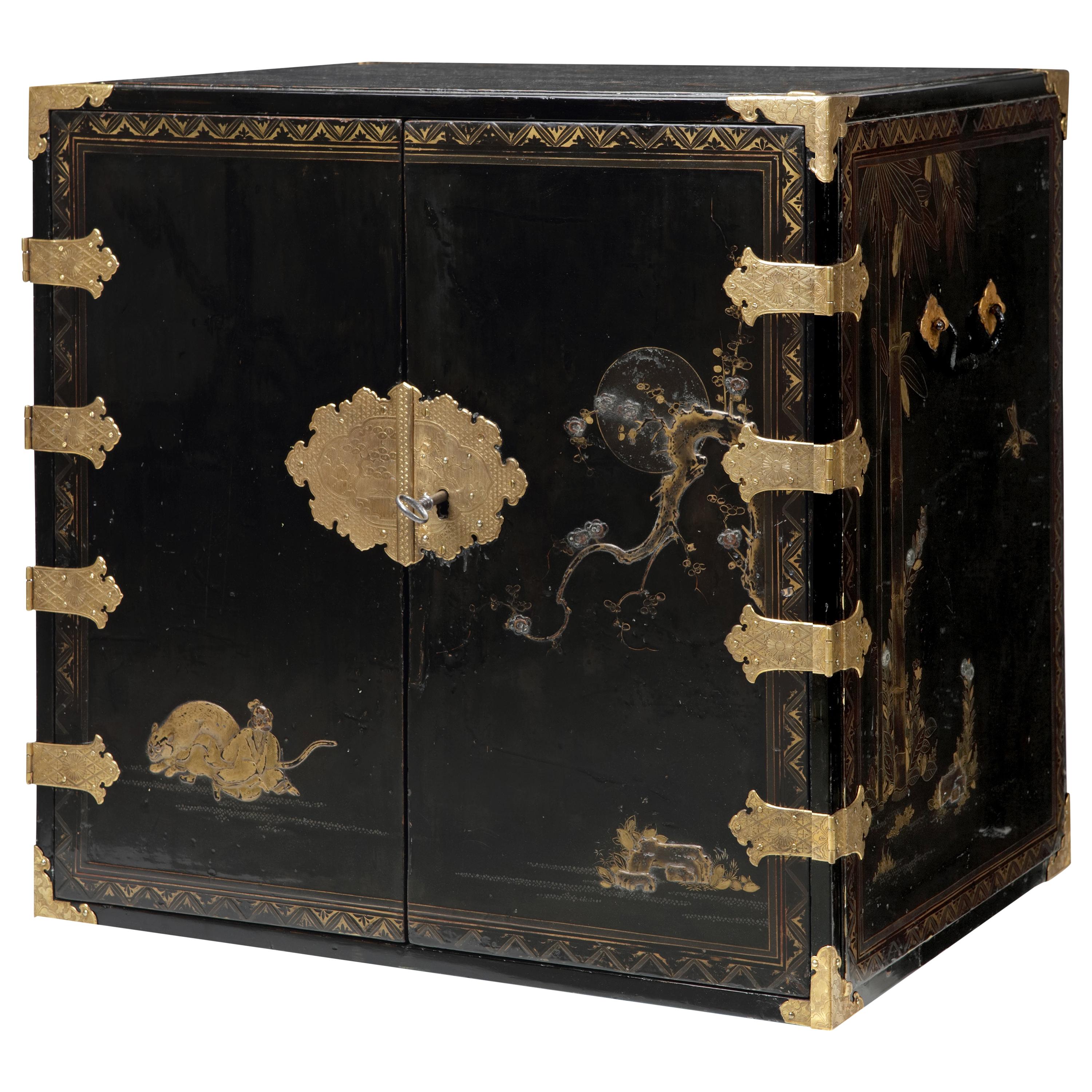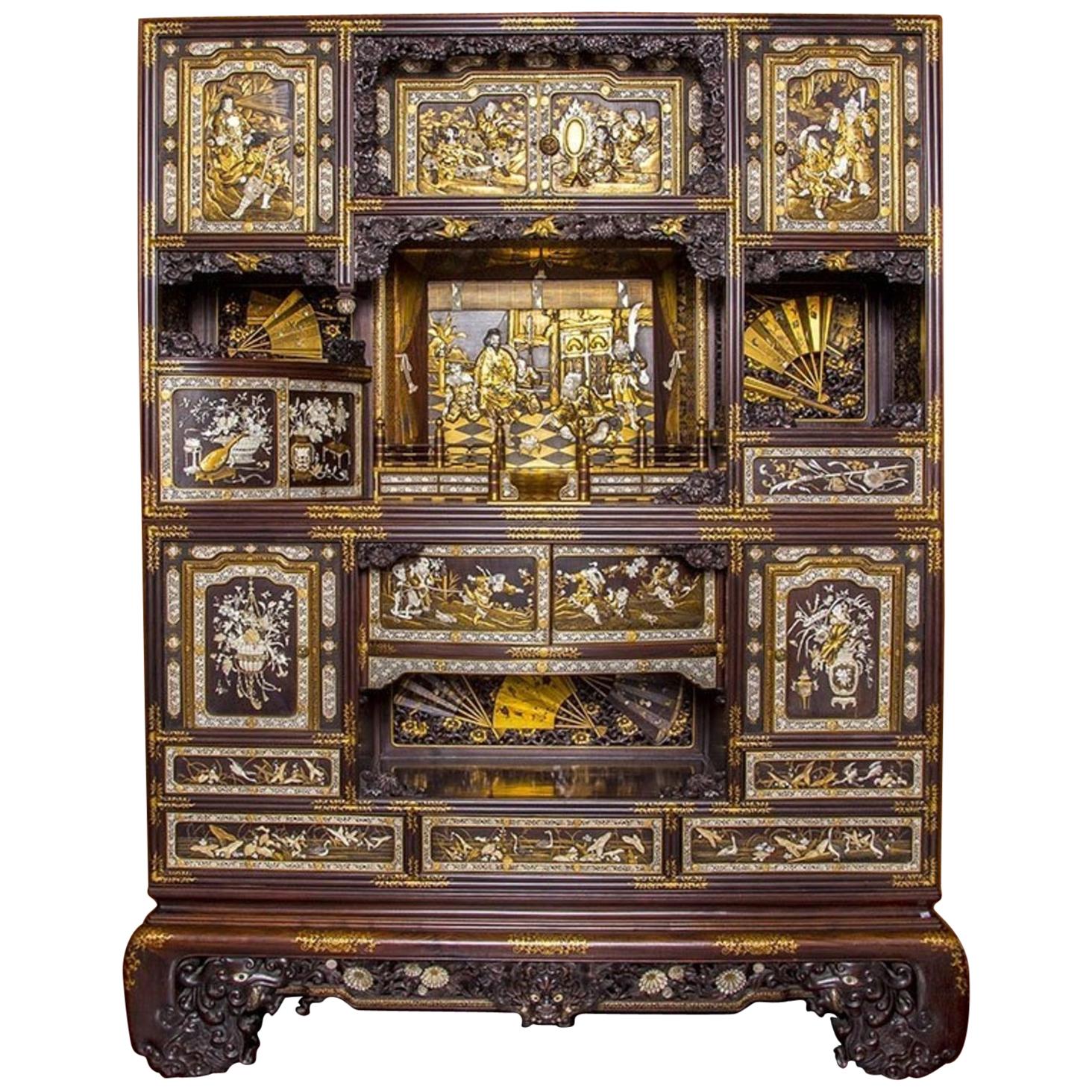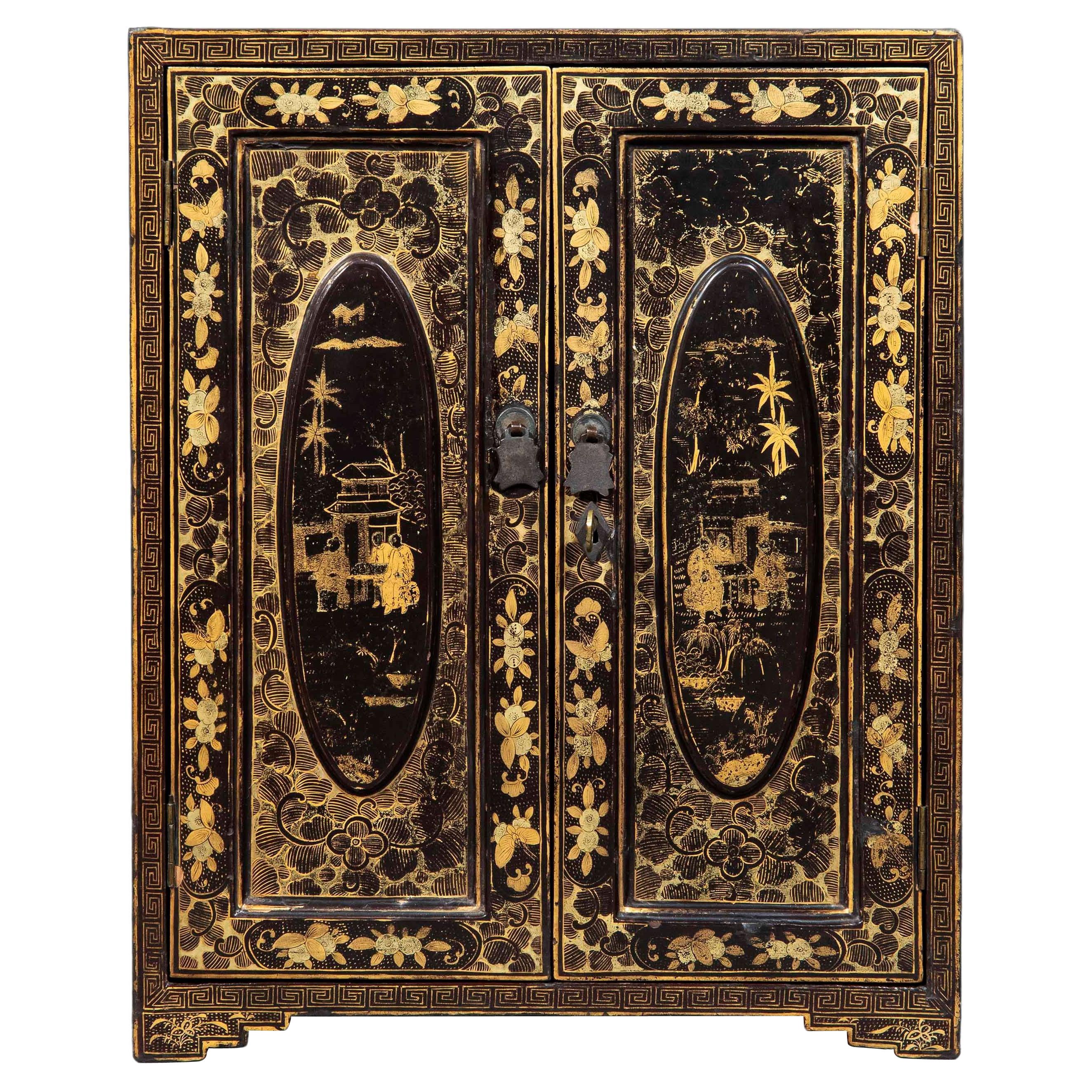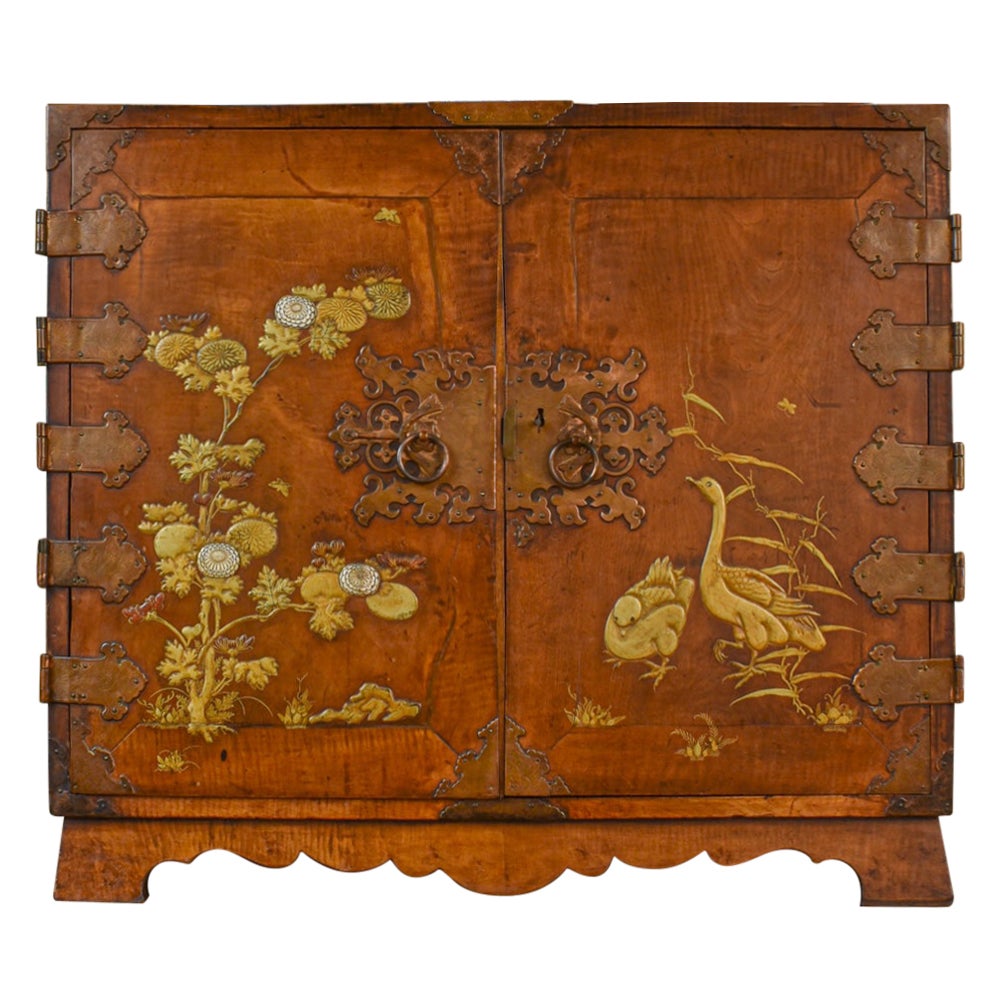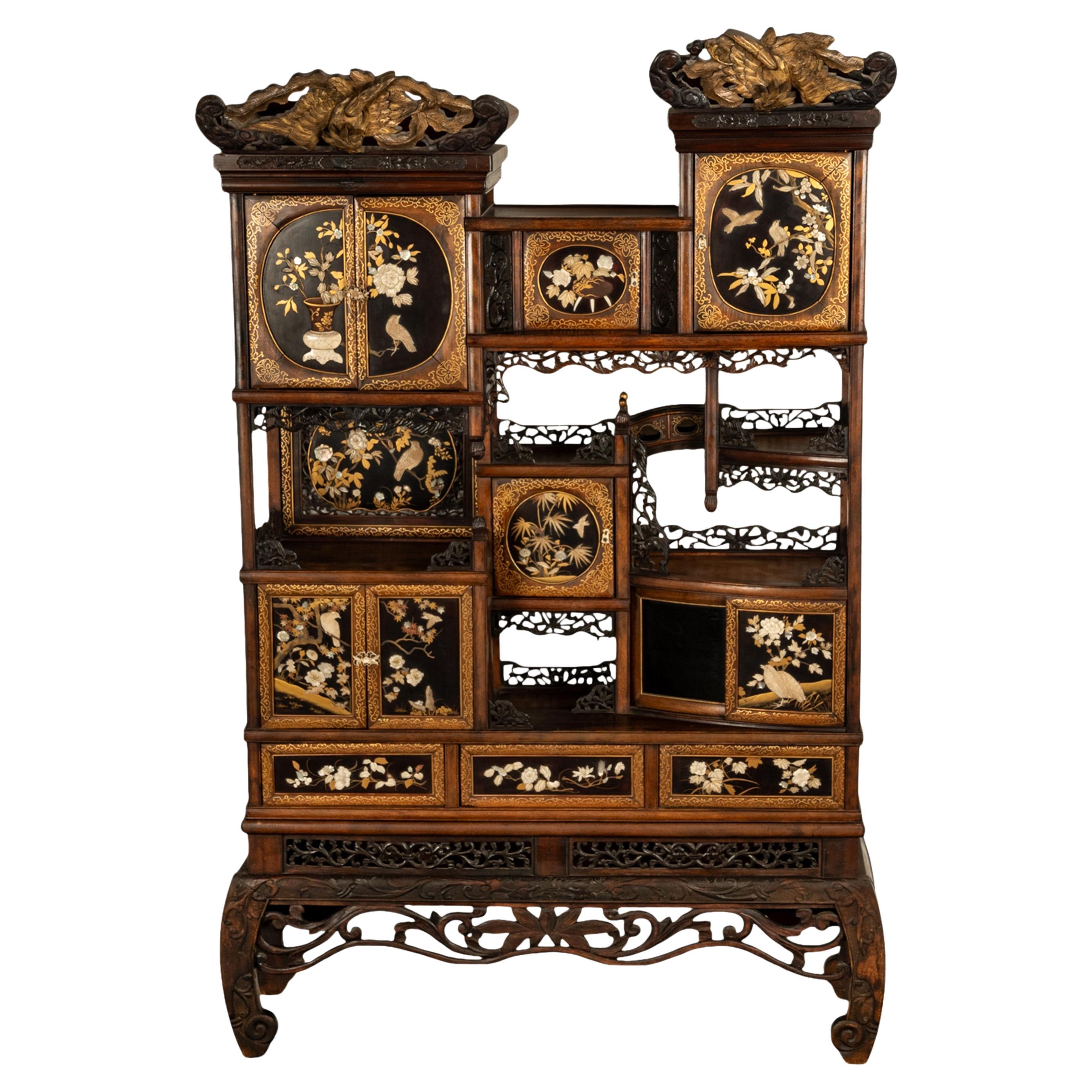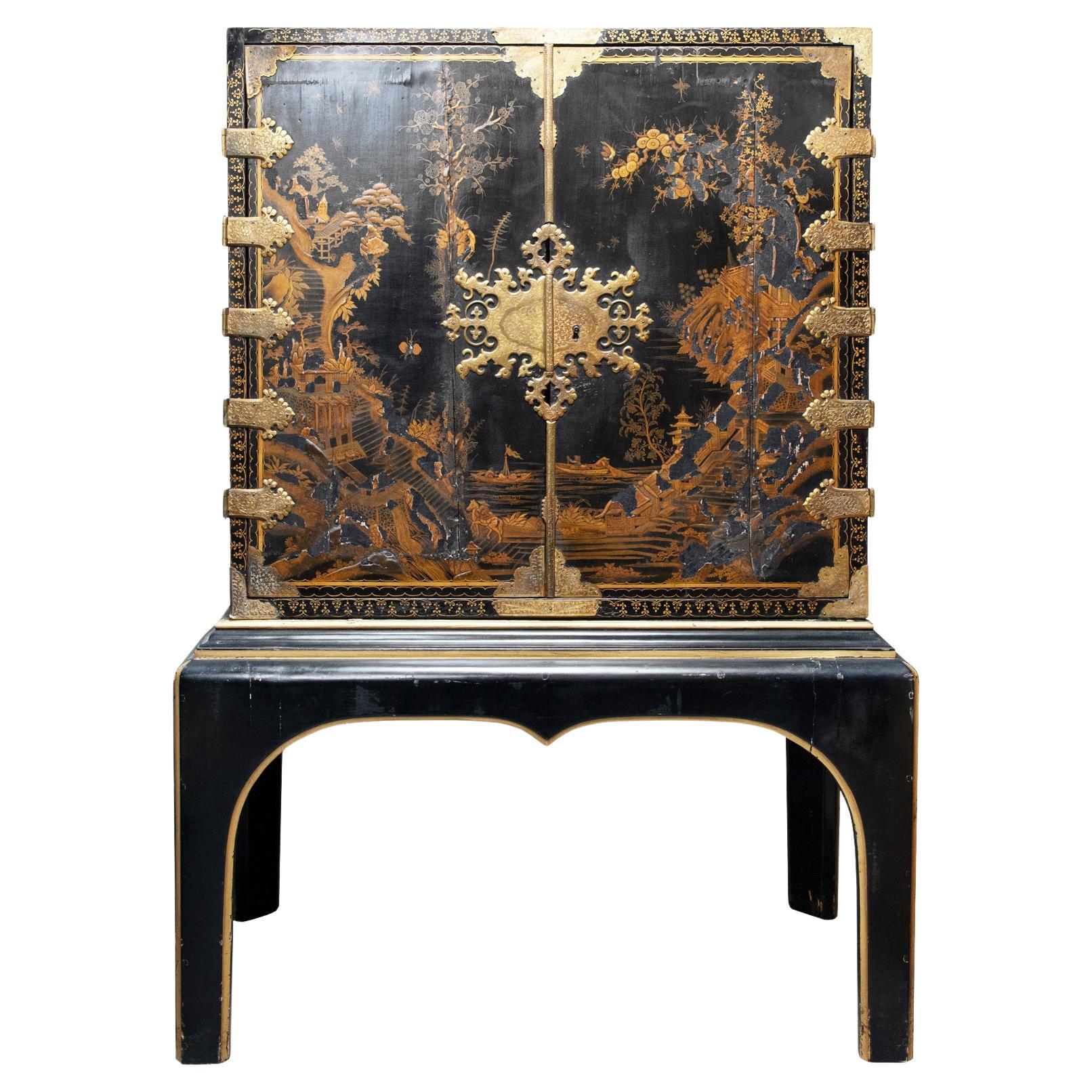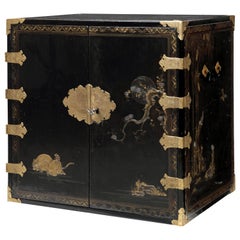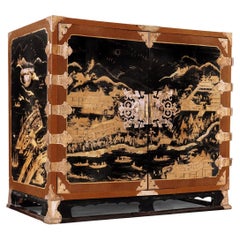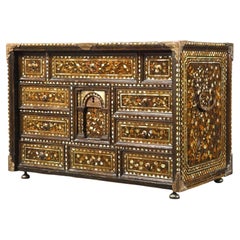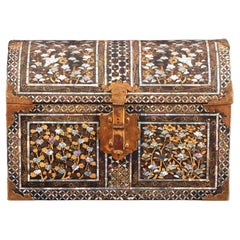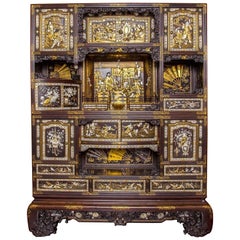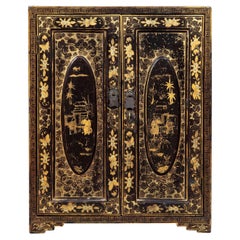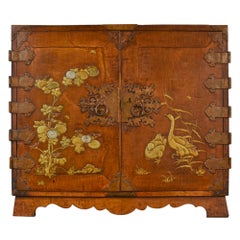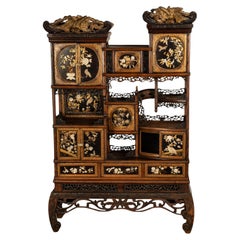Items Similar to Extremely Fine and Rare 17th-Century Japanese Export Lacquer and Inlaid Cabinet
Want more images or videos?
Request additional images or videos from the seller
1 of 10
Extremely Fine and Rare 17th-Century Japanese Export Lacquer and Inlaid Cabinet
Price Upon Request
Price Upon Request
Price Upon Request
Price Upon Request
Price Upon Request
Price Upon Request
Price Upon Request
Price Upon Request
Price Upon Request
Price Upon Request
About the Item
An extremely fine and important Japanese lacquer cabinet with gilt-copper mounts for the European market
Edo period, late 17th century
The pictorial style decorated rectangular cabinet in black lacquer decorated in gold, silver, red and brown very fine taka-maki-e, with inlays in gold, silver, mother-of-pearl, and coral. The left door shows a tapering, high-relief taka-maki-e vase upon a tray with cloud-like patterns. Irises, peonies, and chrysanthemums in polished silver, are amongst the blooming flowers which draw admirers out of their thatched huts on the right-hand door. The doors open to reveal ten various-sized drawers decorated in gold and red lacquer on a black ground, the interior of the drawers in nashiji.
W. 91 x D. 52 x H. 70.5 cm
Provenance:
Property of a Gentleman, the Netherlands
This cabinet belongs to the so-called ‘fine group’ of export lacquer created for the VOC or private traders during the height of Japanese lacquer’s popularity in Europe.
Although the exact meaning of the image remains unclear, it is evident that the arrangement of flowers is in the Rikka style of Ikebana. Rikka arrangements were originally intended as Buddhist offerings, which explains the reverse swastika displayed in the middle of the slender offering vase.
A pair of very similar cabinets, possibly by the same workshop, is in the collection of the Palazzo Reale in Torino, and another Japanese export cabinet showing strong compositional similarities is in Drayton House, Northamptonshire (Oliver Impey & Christiaan Jo¨rg, Japanese Export Lacquer 1580-1850, Hotei Publishing 2005, p. 133).
?Literature:
Oliver Impey & Christiaan Jo¨rg, Japanese Export Lacquer 1580-1850, Hotei Publishing 2005, p. 133 (ill.).
- Dimensions:Height: 27.76 in (70.5 cm)Width: 35.83 in (91 cm)Depth: 20.48 in (52 cm)
- Materials and Techniques:
- Place of Origin:
- Period:Late 17th Century
- Date of Manufacture:1680-1690
- Condition:Wear consistent with age and use.
- Seller Location:Amsterdam, NL
- Reference Number:1stDibs: LU5458229649422
About the Seller
5.0
Recognized Seller
These prestigious sellers are industry leaders and represent the highest echelon for item quality and design.
Established in 1985
1stDibs seller since 2020
23 sales on 1stDibs
Typical response time: 5 hours
- ShippingRetrieving quote...Shipping from: Amsterdam, Netherlands
- Return Policy
Authenticity Guarantee
In the unlikely event there’s an issue with an item’s authenticity, contact us within 1 year for a full refund. DetailsMoney-Back Guarantee
If your item is not as described, is damaged in transit, or does not arrive, contact us within 7 days for a full refund. Details24-Hour Cancellation
You have a 24-hour grace period in which to reconsider your purchase, with no questions asked.Vetted Professional Sellers
Our world-class sellers must adhere to strict standards for service and quality, maintaining the integrity of our listings.Price-Match Guarantee
If you find that a seller listed the same item for a lower price elsewhere, we’ll match it.Trusted Global Delivery
Our best-in-class carrier network provides specialized shipping options worldwide, including custom delivery.More From This Seller
View AllRare Charming 17th Century Japanese Lacquer Cabinet with Gilt-Bronze Mounts
Located in Amsterdam, NL
A fine Japanese pictoral style lacquer cabinet with gilt-metal mounts
Kyoto, Edo period, 1670-1690
Decorated in Japanese relief lacquer work, black lacquer ground decorated...
Category
Antique Late 17th Century Japanese Furniture
Materials
Bronze
$44,788 Sale Price
25% Off
Free Shipping
17th Century Japanese Export Lacquer Cabinet with Depiction the Dutch Tradepost
Located in Amsterdam, NL
A highly important Japanese export lacquer cabinet with depiction of the Dutch East India Company tradepost Deshima and the annual Dutch delegation on its way to the Shogun in Edo
Edo period, circa 1660-1680
H. 88 x W. 100.5 x D. 54 cm
This cabinet includes a later European japanned stand, but also a modern powder-coated steel frame.
The latter can be designed and added to your specific needs.
The sides and front of the rectangular two-door cabinet are embellished in gold and silver hiramaki-e and takamaki-e on a black roiro lacquer ground with a continuous design. The two doors depict a long procession of numerous figures travelling on foot and horseback along buildings and a pagoda into a mountainous landscape. This is the annual court journey, Hofreis, of the Dutch from Nagasaki to the Shogun’s court in Edo. Three horseback riders are dressed as Dutch merchants and a fourth figure, probably het Opperhoofd, is seen inside a palanquin, norimon. Just about to cross the bridge, two men are carrying a cabinet like the present one.
Many Japanese figures on either side of the procession are engaged in various activities; some play musical instruments on board of small boats, others are fishing; figures inside buildings are depicted playing go, and farmers are tending to their rice paddocks. The upper part of the right door shows a large mansion, probably the local daimyo’s castle, with men kneeling before a man in the central courtyard.
The court journey fits in with the foreign policy of the shogunate which accorded a role to the VOC alongside China, Korea, and the Ryukyu Islands who also had to pay tribute. However, the VOC employees were traders, having low status in Japan’s social hierarchy, and they were received with less deference than were the state embassies from Korea and the Ryukyu Islands. Nevertheless, the contacts with the Dutch were a welcome source of information to the Shogun about Europe and European science and technology.
The left side of the cabinet depicts, in mirror image, a rare view of the artificial fan-shaped Deshima Island, the trading post for the Dutch in Japan. The island, where the Dutch flag flies, is surrounded by small Japanese boats and an anchored three-masted fluyt (cargo ship), flying Dutch flags, with on the stern the VOC monogram. On the bottom right a busy street of Nagasaki is shown, bordered by shops and leading up to the stone bridge. On the island the trees are beautifully painted, two cows can be seen, and the flagpole, all in very fine detail. Dutchmen and enslaved Malay are visible outside the buildings and two Japanese figures, probably guards, sit in a small hut in the centre.
A maximum of fifteen to twenty Dutchmen lived on the island at any time and soldiers or women were not allowed. Restrictions on Deshima were tight, and the merchants were only allowed to leave the island by special permission. The Opperhoofd had to be replaced every year, and each new Opperhoofd had to make a court journey to pay tribute, present gifts, and to obtain permission to Margaret Barclay eep on trading. In the distance, many birds fly above the hills and a four-story pagoda can be seen. The right side of the cabinet is painted with other horse riders and their retinue journeying through mountains.
The pair of doors to the front open to reveal ten rectangular drawers. The drawers are decorated with scenes of birds in flight and landscapes with trees and plants. The reverse of the left door with two thatched buildings, one with a ladder, underneath a camelia tree with large blooms; the right door with a three-story pagoda nestled among trees and both doors with a flying phoenix, ho-oo bird. The cabinet, with elaborately engraved gilt copper mounts, hinges, lock plates and brass handles, is raised on an 18th-century English japanned wood stand.
A pair of large cabinets...
Category
Antique 17th Century Japanese Edo Lacquer
Materials
Copper, Gold
$1,492,946
Free Shipping
Portuguese-colonial Japanese Namban lacquer Vargueno Cabinet, circa 1600
Located in Amsterdam, NL
A Portuguese-colonial Japanese Namban lacquer vargueno cabinet
Momoyama period, circa 1600
H. 43 x W. 64.5 x D. 36 cm
Wood, black lacquered and deco...
Category
Antique Early 1600s Japanese Antiquities
Materials
Gold, Brass
Superb Late 16th Century Signed Colonial Japanese Namban Export Lacquer Coffer
Located in Amsterdam, NL
Superb late 16th century signed colonial Japanese Namban export lacquer coffer
Momoyama period, late 16th/early 17th century, inscribed 'Arisato' on the bottom
H. 30.5 x W. 43...
Category
Antique 16th Century Japanese Lacquer
Materials
Cedar, Lacquer
Large Royal Early 17th Century Japanese Lacquer Chest with Gilt-Bronze Mounts
Located in Amsterdam, NL
A large Japanese transitional lacquer chest with gilt-metal mounts
Edo period, early 17th century
The rectangular chest with flat hinged lid decorated in gold, silver, and red ...
Category
Antique Early 17th Century Japanese Blanket Chests
Materials
Bronze
17th-Century Japanese Namban Lacquer Coffer on French Stand, Possibly by Boulle
By André-Charles Boulle
Located in Amsterdam, NL
An impressive and large Japanese 'Namban' transition-style lacquer coffer with fine gilt copper mounts on a French Re´gence base, possibly by André-Charles Boulle (1642-1732)
Kyoto, 1640-1650, the base 18th century
?The coffer with shaped cartouches on a nashiji ground on the lid, front and sides, with fine decorations in various techniques: takimaki-e (high relief), tsuke-gaki (drawing with narrow lacquer lines and over sprinkling with gold and silver), usuniku-takamei-e (demi relief), kimekomi (pushed inside) and accents of kirigane (small geometrical metal mosaics). Inside the cartouche on the lid a landscape with volcanos...
Category
Antique 17th Century Japanese Lacquer
Materials
Brass, Ormolu
You May Also Like
Rare Meiji Period Japanese Lacquer Cabinet
Located in West Palm Beach, FL
Large, rare and important Meiji period, late 19th century, Japanese lacquer cabinet
Meiji period (1868-1912)
19th century
In three parts, desi...
Category
Antique 19th Century Furniture
Materials
Wood
19th Century Lacquer Cabinet, Circa 1850
Located in Richmond, London
A striking black lacquer table or jewellery cabinet, exquisitely decorated with Oriental figures and pagodas throughout. Mid-19th century. A highly desirable and sought after model.
...
Category
Antique 19th Century Asian Chinoiserie Lacquer
Materials
Lacquer
Fine and Rare 17th Century Japanese Mulberry Wood Gilt-Lacquer Cabinet on Stand
Located in Lymington, GB
An outstanding and rare, 17th-century Japanese mulberrywood gilt-lacquer cabinet raised on a later stand.
This fine and exceptional two-door, gilt-heightened cabinet - reputedly in mountain mulberry wood...
Category
Antique 17th Century Japanese Cabinets
Materials
Lacquer
Antique Japanese Lacquer Inlaid Hardwood Meiji Period Shibayama Shodana Cabinet
Located in Portland, OR
An exquisite antique Japanese Meiji period Shibayama Shodana cabinet, circa 1880.
One of the finest antique Shibayama cabinets one will see, ...
Category
Antique Late 19th Century Japanese Meiji Furniture
Materials
Gold
Early 18th century Japanese Lacquer Cabinet on Stand
Located in Rīga, LV
Rectangular cabinet has nine drawers inside. Hinges, corner mounts and lock plates in gilt brass. Decorated with river landscapes, insects, birds and animals in pairs. The stand is i...
Category
Antique Early 18th Century English George III Cabinets
Materials
Wood, Lacquer
19th Century Japanese Lacquer Table Cabinet
Located in Richmond, London
A fine and rare Japanese black lacquer table or jewellery cabinet, exquisitely decorated in intricate detail, dating to the late Meiji per...
Category
Antique Late 19th Century Japanese Meiji Lacquer
Materials
Metal
More Ways To Browse
Brown Lacquered Cabinet
Lacquered Cabinets
Antique Inlaid Cabinet
Black Gold Lacquer
Japanese Gilt Wood
Japanese Lacquer Cabinets
Black Lacquered Cabinets
Black Lacquer Mother Of Pearl
Japanese Wood Tray
Japanese Export Silver
Japanese Wood Inlay
17th Century Brass Furniture
Japanese Lacquered Tray
Gold Lacquer Tray
Maki E
Black Lacquer Mother Of Pearl Inlay Furniture
Antique Hut
Japanese Lacquer Pearl
